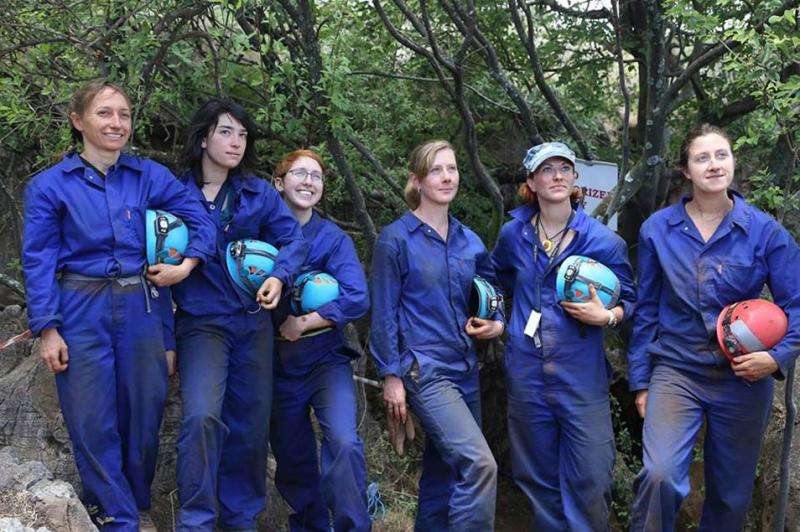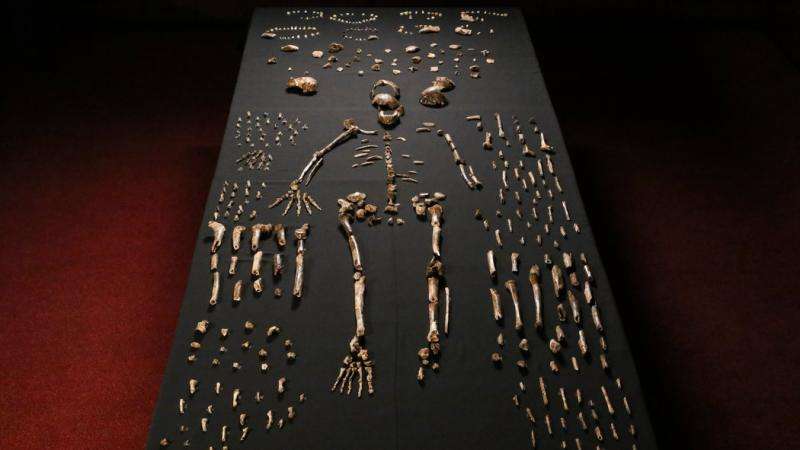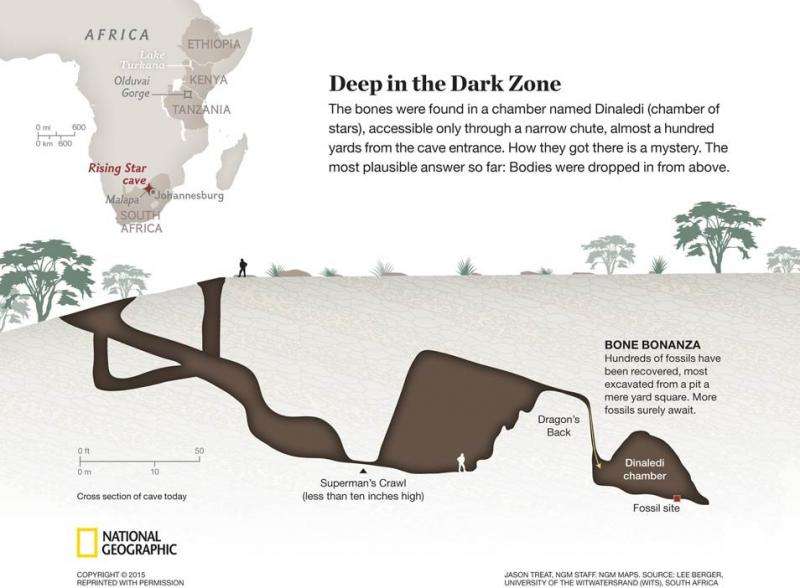Little women: The team of scientists who excavated the cramped chamber where H. naledi was discovered. Left to right, Becca Peixotto, Alia Gurtov, Elen Feuerriegel, Marina Elliott, K Lindsay (Eaves) Hunter and Hannah Morris. Credit: John Hawks
As you know, most fields of science, especially the ones best beloved by media, are dominated by white guys. Paleoanthropology, for example. Unless you are pretty familiar with human paleontology, Meave Leakey is likely to be the only female name that springs to mind (not counting Lucy.) And doubtless it helps that she is part of the most famous family in that field.
But what may turn out to be the biggest human origins tale ever depends entirely on the 6 women paleontologists who made it happen: Marina Elliott, Elen Feuerriegel, Alia Gurtov, K Lindsay (Eaves) Hunter, Hannah Morris, Becca Peixotto. Literally the biggest: 1550 hominin fossil bones recovered so far, parts of at least 15 individuals, most of them from just a single square yard of the site. Many more bones are still to be unearthed.
These scientists made it possible because they were able to wriggle their way through the narrow passageways, 300 feet down into the hidden chamber where lay the bones of what the researchers are calling Homo naledi. In November 2013, Elen Feuerriegel gave us a first-person tour at the Rising Star blog. More recently David Smith describes these journeys, and the fossil recovery process, at the Guardian.
As paleontological finds go, this one went fast, with papers appearing just two years after discovery by fossil-hunting cavers exploring Rising Star, a well-mapped cave 30 miles north of Johannesburg. At National Geographic, which funded this project, Jamie Shreeve recounts how the discovery came about.
He sets this history in the context of what is already known about human evolution and about head man Lee Berger of the University of the Witwatersrand in Johannesburg, whose ideas about the geography of human origins have been controversial and often ignored.
What does H. naledi look like? Apelike and primitive above and humanlike below. Shoulders well adapted for climbing but feet nearly indistinguishable from ours. So, both a climber and a walker, which is odd. Not so tiny, the males nearly 5 feet tall and weighing about 100 pounds.
But a tiny brain, only about a third the size of ours. More like Australopithecus than Homo, but in his Why Evolution is True post setting the find in the context of what is known about human evolution, Jerry Coyne explains why these are not the bones of Australopithecus.
Says Shreeve, "These were not human beings. These were pinheads, with some humanlike body parts." The researchers have declared nevertheless that these people were members of our own genus, Homo, and have named them Homo naledi. Coyne is skeptical.
Other details about H. Naledi
Bones of Homo naledi. This is a composite skeleton, put together from bones of different individuals. Credit: John Hawks
The site contains no rock so is technically a challenge to date. Thus the age of these fossils is unknown. They might be 2 million or more years old–or only 100,000 or so. Radiocarbon dating might work but would involve destruction of bone. It's been delayed so analysis can be completed first.
Dating will be critical for making sense of H. naledi's place in our own story. Many are calling H. naledi a new human ancestor, including the project's head guy, Lee Berger. But whether these people were actually our forebears or only our cousins is not at all clear. Knowing when they lived would be illuminating.
Indeed, whether H. naledi is even a new species is in dispute already. Ian Sample at The Guardian interviewed paleontologists who think the fossils might be a population of Homo erectus, named in the 19th century.
This is a reasonable argument. H. erectus roamed the world and in appearance was very various. A previous On Science Blogs post about the remarkably heterogeneous H. erectus fossils at Dmanisi in Georgia discussed this widespread diversity, and the paleontological disputes between splitters, who see every new find as a new species, and lumpers, who don't.
Paleontologists Jeffrey Schwartz and Ian Tattersall suggested in the Aug. 28 issue of Science that the bones might represent at least two different species. And Tattersall told the New York Times it might turn out that Homo naledi was not Homo at all.
Prospects for getting DNA that could help with settling these questions do not look particularly good. The site is warm and wet. Recovery of ancient DNA works best when the fossil bones have come from places that are cold and dry.
In addition to whatever the bones turn out to mean, the project was a bit of a revolution in scientific methodology. Berger recruited dozens of young paleontologists to make quick work of tasks like analyzing and measuring the hundreds of bones, a job that would have taken years with a conventional small team.
It was also an attempt at open science. There was a project blog, although it was often impressionistic rather than descriptive–and it shut down in April 2014, in a post by Becca Peixotto as excavation concluded. It resumed this week with the publication announcement.
John Hawks, the main paper's second author, wrote about the project at his own well-known paleoanthropology blog (posts tagged Rising Star) and also explained the goals of open science at the project blog. "Rising Star is the most open paleoanthropological project that has ever been attempted," he said in November 2013.
How did H. Naledi get to this hidden chamber?
Noteworthiest of all, it's hard to avoid the conclusion that these bones were interred deliberately. The people weren't living there: no tools, no food remains. They weren't cannibalized or dragged there by carnivores: no toothmarks or other injury to the bones. They weren't washed into the chamber on a flood: no rubble or debris. There were bones of a bird and a few rodents but otherwise no fossil animals. This place was really hard to find.
The most parsimonious explanation for the site seems to be that other humans carried the corpses of infants and children and adults old and young to this sequestered spot and dumped them down a chute into the chamber. It appears that the chamber may always have been a challenge to get to.
There is no evidence that these acts were accompanied by ritual or anything resembling religious observance. But it's hard to imagine what the chamber might have been if not a tomb, a way of protecting the remains of valued relatives and friends.
Which would make it an unprecedented and stunning example of cultural practices in a creature with a brain the size of an orange. From the anonymous snide account at Uncommon Descent, an "intelligent" design blog: "Maybe big brains are about as useful as big behinds? The way big 1980s computers were superior to the current I-pad. Has anyone ever studied any of this seriously? Or is it just more tax-funded Darwinblither?"
Journal information: Science
Provided by Public Library of Science
This story is republished courtesy of PLOS Blogs: blogs.plos.org.


























